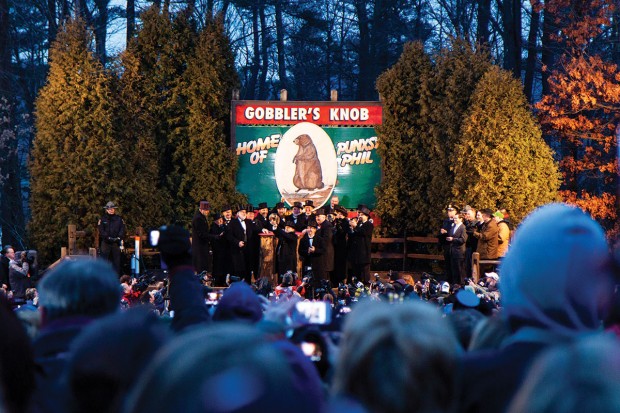Groundhog Day
Do we really want winter to end?

IT’S NOT A TEXAS THING Ben Portnoy, who grew up in Ohio, laments the irrelevance of Groundhog Day here in Texas. Pictured is a Groundhog Day celebration in Punxsutawney, Pennsylvania. Tradition bears that if the iconic groundhog Punxsutawney Phil sees his shadow, winter is forecasted to last another six weeks. (Photo by Steve Wrzeszczynski on Unsplash)
Since moving to Houston more than 50 years ago, it has always made me sad that we pay such little attention to Groundhog Day. I grew up in Ohio, and February 2 – Groundhog Day – was of some importance. By then, we were usually tired of all the snow and ice. The tradition is that on that day, the groundhog comes out of hibernation and looks around. If it is a clear day and he (or she) sees his/her shadow, he/she will return to his/her den, and winter is said to last another six weeks. If the day is cloudy and the creature cannot see his shadow, then winter is said to draw to a close sooner, and we all get to enjoy an early spring.
I know that February has some other holidays like Presidents’ Day and Valentine’s Day, so maybe Groundhog Day gets crowded out. Or maybe it’s because in Texas we just don’t care when winter will end. Come to think of it, after last summer, we probably are hoping winter will last longer. Still, I like to observe Groundhog Day. It’s nice to know what the groundhog will predict for our friends up north.
Groundhog Day has a long history. German-speaking Pennsylvania Dutch observed the day beginning in the 16th century. In Europe, the animal observed was the badger and, in some places, a bear or a fox. In 1886, the Punxsutawney Spirit, the local newspaper of a town in western Pennsylvania, reported on February 2 that the groundhog had seen his shadow. The next year, a group of Punxsutawney citizens marched to a place called Gobbler’s Knob in their town and began the annual ritual of observing the groundhog’s behavior on February 2. Only in 1961 did the index animal get the name Punxsutawney Phil.
Why February 2, you ask? It turns out that in ancient Roman times a ceremony was conducted on that date to honor the god Februus. There would be processions of citizens holding candles. Celtic populations observed cross-quarter days. These are days that fall halfway between a solstice and equinox. The Celtic holiday, Imbolc, later became Candlemas, a day for a candle procession. It is observed on February 2, and the days of the holiday are halfway between the winter solstice (around December 21) and the spring equinox (around March 21). Winter weather prediction became associated with Candlemas, and the badger and its descendant groundhog were adopted as the predictors.
The 1993 film Groundhog Day is considered a classic, but personally, I am troubled by the plot. It has cast a false meaning to this important yearly celebration. The movie depicts events happening over and over again, and that really has nothing to do with the deep historic significance of Groundhog Day. Some use the term Groundhog Day to scorn events that repeat over and over. Please dismiss that meaning from your mind if it was ever there.
What of the groundhog? It is more formally known as Marmota monax, and others call it a woodchuck. Last spring, I was in northern Ohio birdwatching during migratory season. It was getting late, and I was walking by a creek looking for a purple gallinule that had been spotted by others. This would be a most unusual bird for that area. Something moved, and I was ready to spot my bird when a furry creature larger than a squirrel popped out of some reeds by the creek. Another birder was standing by me, and I asked, “What in the world was that?” He informed me that I had just seen a groundhog. Life goal completed.
This all may seem silly to you, and I’ll admit that it probably is silly, but keep in mind that there are lots of days designated for even sillier things. Take November 14 for instance. That is National Pickle Day. What you are supposed to do on that day is clear, but what if you prefer olives? A personal favorite is National Bow Tie Day. That is August 28 for you four-in-hand guys. July 11 is National Swimming Pool Day. It’s a good thing that is not in February. If you don’t like swimming, then the first Wednesday in June is Global Running Day. Probably the day we should all observe is May 11, since that is National Eat What You Want Day. You are officially given permission to indulge in anything you want, even a bag of M&M’s.
But I go back to Groundhog Day. It is coming up, and we will then know if 90-degree weather will hit us in March or April. I wonder, though, whether we should put our trust in a groundhog. Maybe an armadillo would be better for us Texans. And if that confuses you, I am here to inform you that February 2 is also World Ostrich Day. No kidding.
Editor's note: It turns out one Buzz-area family makes a big deal out of Groundhog Day every year. Read about their traditions here.
Want more buzz like this? Sign up for our Morning Buzz emails.
To leave a comment, please log in or create an account with The Buzz Magazines, Disqus, Facebook, or Twitter. Or you may post as a guest.


